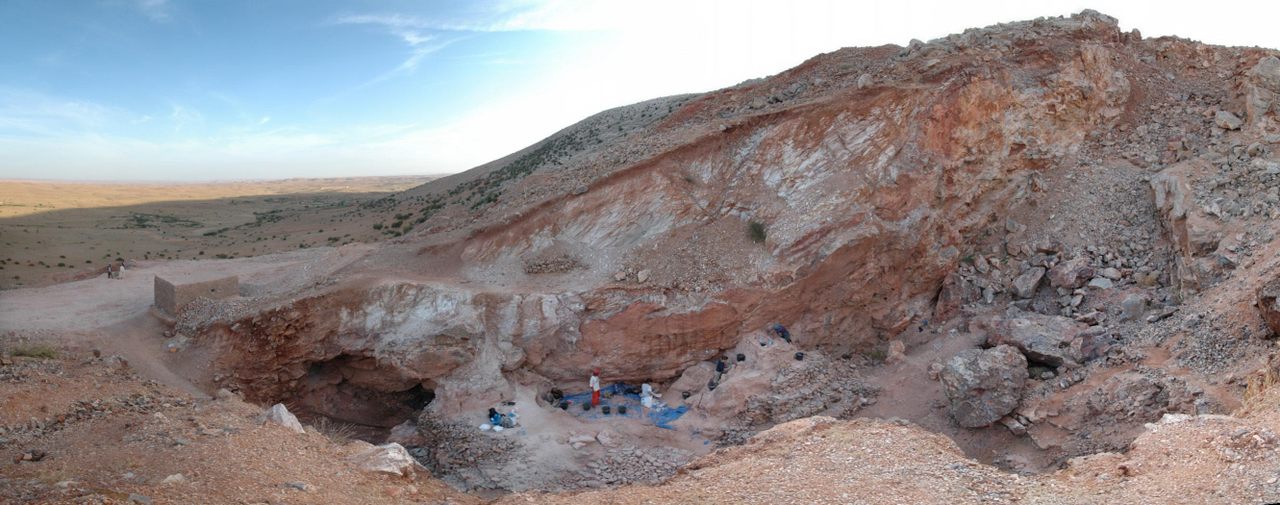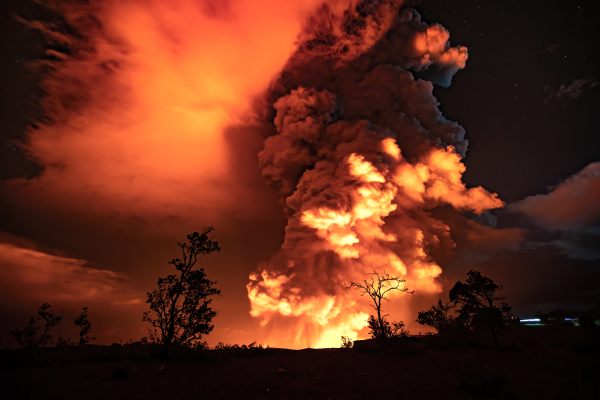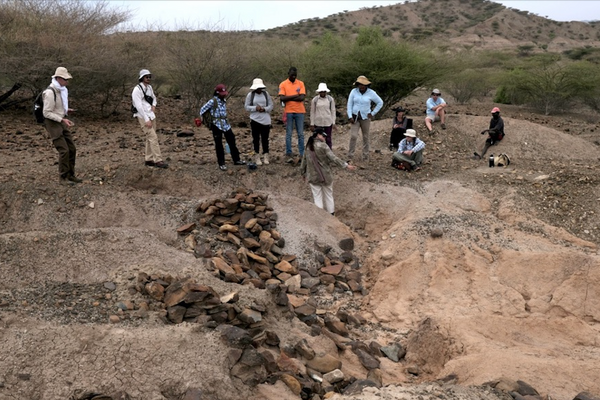Where Did Humans Evolve? (Probably Not Where You’re Thinking)
For decades, East Africa was considered the birthplace of our species. Fossils from Morocco suggest otherwise.

Drive west about two hours from the vibrant souks of Marrakech and you will reach the small village of Tlet Ighoud. The rural community stretches along the intersection of two narrow, minor highways. If you follow one of them north for a couple miles, you’ll find an old pit from an abandoned mining operation.
In this arid region, the site’s tumble of red and orange rocks seems like nothing special, but it was here, more than 60 years ago, that miners uncovered what appeared to be a human skull. The find was the first of many from the site known as Jebel Irhoud. Collectively, the discoveries there have shaken up the story of our species, by challenging two of the most fundamental questions we can ask: When did we evolve and where did we come from?
For decades, those questions have been answered based on bones. But all of the early Homo sapiens fossils known to science could comfortably fit in your living room with space to spare. Most come from East African sites, such as northern Tanzania’s Ngaloba beds, or Omo Kibish, a collection of locations nestled in a remote Ethiopian river valley. Fossils from both of those locales, and others in East Africa, have been dated to between 120,000 and 200,000 years ago, and long represented what scientists thought was the earliest chapter in the story of H. sapiens. (In 2022, using a more refined dating method, researchers discovered that Omo I, a skull from Omo Kibish, is around 233,000 years old.) Working with that fossil evidence, it made sense to think that we had evolved in East Africa. After all, the region had also been home to several earlier members of our family tree, including celebrity fossil Lucy (the most famous example of Australopithecus afarensis, which lived around three million years ago).

When miners unearthed that first skull from Jebel Irhoud in 1961, it was assumed to belong to a Neanderthal—modern humans’ closest evolutionary relative, H. neanderthalensis—who had lived some 40,000 years ago. Subsequent analysis suggested it was actually H. sapiens, and pushed the age of the skull back to about 160,000 years—much earlier in the human story, but still younger than several of the fossils found in East Africa. Our species evolved to walk and run long distances, so it would be no great feat for early humans to spread across Africa in the millennia after our birth in the east.
Then, in the early years of the 21st century, a new team of paleoanthropologists arrived at Jebel Irhoud. They picked over spots that had been chewed up by the mining operation, where the first fossils were found, but also began excavating new and previously undisturbed areas. They went back further in time as they dug. There, in those older layers of rock, they found additional skulls, other human bones, stone tools, and ribs of zebras and gazelles that show clear evidence of having been butchered for food.
Later came the biggest news of all: Using multiple methods, the team determined the finds were about 300,000 years old. The Jebel Irhoud fossils, which include skulls with distinctively modern human faces, were tens of thousands of years older than any human fossil found in East Africa.
The discovery, published in a series of papers and reactions in Nature in 2017, made headlines—and created controversy. Critics noted that while the facial features of the Jebel Irhoud skulls were remarkably modern, the overall shape of the skulls was longer and lower than the bubble-like, rounded braincase of modern humans. That difference, they argued, made a case that the Jebel Irhoud individuals were actually not H. sapiens, but might belong to an earlier species, such as H. antecessor, which lived about a million years ago in Spain.

The team behind the 2017 findings, led by paleoanthropologists from Germany’s Max Planck Institute for Evolutionary Anthropology, remained steadfast in their assessment of the Jebel Irhoud fossils as H. sapiens. But they were also the first to caution that Morocco should not be considered the birthplace of our species.
There are, after all, a few other very early fossils, such as a skull from Florisbad, South Africa, that is at least 260,000 years old. That skull resembles the Jebel Irhoud examples, found on the opposite side of the continent, and is also considered by some paleoanthropologists to belong to early H. sapiens. The only way both the Florisbad and Jebel Irhoud individuals could belong to our species is if humans evolved much earlier than we thought, which could put our true birthplace anywhere on the continent.
While exactly where and how the Jebel Irhoud humans fit into our origin story remains uncertain, their fossils have fueled a shift in how we view human evolution. Since 2017, more paleoanthropologists have moved away from the idea that we evolved fully in East Africa and then dispersed across the continent and beyond.
Today, more researchers embrace a Pan-African idea of human evolution, which hypothesizes that our species evolved across a wide geographic area as multiple populations mixed and mingled. That theory got a boost in 2023, when genomic research published in Nature concluded that humans evolved from two ancestral populations that occasionally interbred over hundreds of thousands of years.
It was beyond the scope of that 2023 paper to determine the geographic range of these ancestral populations, but the role geography plays in forming our ideas about human evolution is often overlooked. There are many regions of Africa where highly acidic soil or other environmental conditions make fossilization almost impossible—bones there break down before they can be preserved, erasing any evidence of our ancestors. In other areas, notably East Africa, paleoanthropologists have found early human fossils because, frankly, that’s where they went looking for them. (It’s a similar story in South Africa, home to several important fossils of multiple early human relatives and the boldly named Cradle of Humankind, which stakes the country’s claim, over East Africa, as our first home.)
But back to your living room, the one theoretically filled with every early H. sapiens fossil ever found: That’s still all we have from our earliest chapters. Interpreting them is like trying to read a version of Darwin’s On the Origin of Species that’s been printed without any vowels—or most of the consonants, for that matter. Understanding the true map and timeline of human evolution will require finding and analyzing many, many more fossils, and as well as the clues tucked into DNA from both living and ancient populations. We may never know exactly where and when the first human was born, but with every fossil found, the likeliest spot shifts in both time and place. The next big shift may be only one strike of a miner’s pickaxe away.




















Follow us on Twitter to get the latest on the world's hidden wonders.
Like us on Facebook to get the latest on the world's hidden wonders.
Follow us on Twitter Like us on Facebook